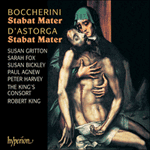Hans Volkmann, Astorga’s great champion and biographer at the start of the twentieth century, dated the
Stabat mater, purely (and rather debatably) on stylistic grounds, to around 1707. There are equally valid arguments for any date up to around 1730. Whatever, throughout we see Astorga’s gift for writing warm melodies, typical of the Neapolitan style of the time. He also captures the melancholy of this most desolate of sacred texts and, especially in the choruses, demonstrates a thorough grasp of counterpoint, but never at the expense of musicality. The work sets twenty of the standard three-line verses, connecting four for the third, double-duet movement, but otherwise using pairs for the independent movements. In his scoring Astorga takes a variety of combinations of chorus, solo, duet and trio. The mixture of melody with melancholy, sweetness tempered with mild chromaticism, old-fashioned polyphony contrasted with Neapolitan cantilena, a surprisingly Germanic use of motivic development in the bel canto bass solo ‘Fac me plagis vulnerari’ and the final, quietly operatic chorus which gently directs the listener away from the Virgin’s sorrow towards the Carmelite missal’s more optimistic ‘palm of victory’, all show an enormously attractive musical style. Composers and their work often enjoy a bumpy progression through history, but few paths can have been as bizarre as that of Astorga: in the eighteenth century a musical nobleman, during the nineteenth century a folk hero, and in the twentieth—oblivion.
from notes by Robert King © 1999
Hans Volkmann, grand apôtre et biographe de Astorga au début du XXe siècle, data le
Stabat mater des environs de 1707, mais en se fondant sur des bases purement stylistiques (ce qui est quelque peu sujet à débat). En fait, des arguments tout aussi valables permettent d’étayer n’importe quelle date jusqu’en 1730. Qu’importe. Cette œuvre laisse voir le don de Astorga pour l’écriture de mélodies chaleureuses, typiques du style napolitain de l’époque. Le compositeur appréhende également la mélancolie du texte—le plus désolé de tous les textes sacrés—et, surtout dans les chœurs, fait montre d’une profonde compréhension du contrepoint, mais jamais aux dépens de la musicalité. L’œuvre met en musique dix des habituelles strophes de six vers, qui forment des mouvements indépendants, à l’exception du troisième mouvement, un double duo pour lequel deux strophes sont appariées. L’écriture de Astorga embrasse diverses combinaisons de chœurs, de solos, de duos et de trios. Le mélange de la mélodie à la mélancolie, la douceur tempérée par un léger chromatisme, la polyphonie surannée mise en contraste avec la cantilène napolitaine, un usage étonnamment germanique du développement motivique dans le solo de basse (un bel canto) «Fac me plagis vulnerari» et le chœur final, paisiblement opératique, qui éloigne calmement l’auditeur de l’affliction de la Vierge pour l’emmener vers «la palme de la victoire», plus optimiste, du missel carmélitain sont autant d’éléments révélateurs d’un style musical des plus séduisants. Les compositeurs et leurs œuvres jouissent souvent d’une progression cahotique dans l’histoire, mais peu de parcours ont été aussi bizarres que celui de Astorga: noble musicien au XVIIIe siècle, héros populaire au XIXe et … musicien oublié au XXe.
extrait des notes rédigées par Robert King © 1999
Français: Hypérion
Hans Volkmann, Astorgas begeisterter Fürsprecher und Biograph zu Beginn des 20. Jahrhunderts, datierte das
Stabat mater mit auschließlich (und umstritten) stilistischer Begründung auf die Zeit um 1707. Ebenso stichhaltige Gründe ließen sich für jedes Datum bis etwa 1730 anführen. Auf jeden Fall erkennen wir darin durchweg Astorgas Begabung für das Schreiben warmherziger Melodien, wie sie für den neapolitanischen Stil jener Zeit typisch waren. Außerdem fängt er die Melancholie dieses trostlosesten aller geistlichen Texte ein und demonstriert insbesondere in den Chören seine eingehende Beherrschung des kontrapunktischen Satzes, nie jedoch auf Kosten der Musikalität. Das Werk vertont zehn der gewohnten sechszeiligen Verse und faßt zwei zum dritten Satz zusammen, einem Doppelduett; ansonsten bildet jeder Vers einen eigenen Satz. Astorga setzt die verschiedensten Kombinationen von Chor, Solo, Duett und Trio ein. Ein Gemisch aus Melodik und Melancholie, Lieblichkeit, die durch milde Chromatik ausgeglichen wird, altmodische Polyphonie und im Kontrast dazu neapolitanischer Kantilenenstil, die überrraschend deutsch anmutende motivische Arbeit im Belcanto-Baßsolo „Fac me plagis vulnerari“ und der abschließende, unaufdringlich opernhafte Chor, der den Hörer sanft von der Trauer der Jungfrau ablenkt und zur optimistischeren „Siegespalme“ des karmelitischen Meßbuchs hinführt—das alles sind Belege für einen ungeheuer attraktiven Musikstil. Komponisten und ihr Schaffen sind oft den Unwägbarkeiten der Geschichte ausgesetzt, doch können nur wenige Entwicklungen so bizarr verlaufen sein wieder die von Astorga: im 18. Jahrhundert ein musikalischer Edelmann, das 19. Jahrhundert hindurch ein Volksheld, und im 20. Jahrhundert—Vergessenheit.
aus dem Begleittext von Robert King © 1999
Deutsch: Anne Steeb/Bernd Müller


 Boccherini & Astorga: Stabat mater
Boccherini & Astorga: Stabat mater
